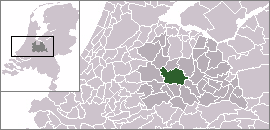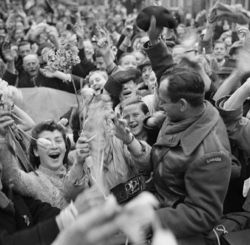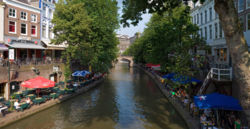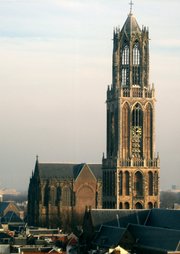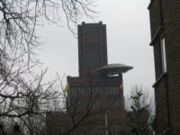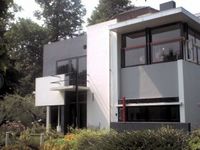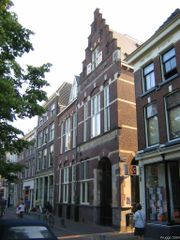Utrecht (city)
2007 Schools Wikipedia Selection. Related subjects: European Geography
- There is also Utrecht, KwaZulu-Natal in South Africa, which gave its name to one of the former Boer republics
| Utrecht | |
| Country | Netherlands |
| Province | Utrecht |
| Coordinates | |
| Area | 99.32 km² |
| - Land | 95.67 km² |
| - Water | 3.65 km² |
| Population (2006) | 283,000 |
| - Density | 2,883/km² |
Utrecht ( pronunciation ( help· info)) is a municipality and the capital city of the Dutch province of Utrecht. It is the fourth largest city of the Netherlands.
History
The origin of the city is a Roman fortification ( castellum) around the year 47. Originally built from wood at the river Rhine, which had a more northern bed than nowadays, it was a border fortress of the Roman Empire. The name of the place was Traiectum, which means fordable place; later with the addition Ut (near to the mouth) to distinguish it from other settlements near fords. In the middle ages it appeared on maps as Ultra Traiectum (beyond the ford - as the city was north of the Rhine); which names merged and changed into the current name (Utrecht). In the second century the wooden walls were replaced by sturdier stone walls, remnants of which are still to be found below the buildings around Dom square. Around 500 Romans were encamped here. Near the fort there was a settlement with artisans, traders and soldiers' women and children.
In the middle of the 2nd century Germanic tribes regularly invaded the Roman territories, and around 270 the Romans left Utrecht. About the period 270- 500 little is known. In the 6th century Utrecht came under the influence of the Franks.
During the Middle Ages Utrecht was the most important city of the Northern Netherlands. Willibrordus is usually considered to be its first bishop. In 695 he was appointed archbishop of the Frisians and in 703 or 704 Pepin II of Herstal gave him Utrecht as see for his missionary activities further north. Utrecht received city rights in 1122.
Later the bishops of Utrecht exercised worldly power as prince-bishops not only in the province of Utrecht (Nedersticht, 'lower Sticht') but also further to the northeast. The Veluwe soon became part of Gelre but Overijssel remained the Oversticht. In 1528 the wordly power over both Neder- and Oversticht was transferred to Charles V, Holy Roman Emperor, who became the Lord of the 17 Netherlands (the current Benelux and the Northern parts of France). This transition was not an easy one and Charles V had to build castle Vredenburg to maintain order in the city.
In 1579 the northern seven provinces of these Low Countries signed the Union of Utrecht, in which they decided to join forces against Spanish rule. The Union of Utrecht is seen as the beginning of the Dutch Republic. In 1580 this predominantly Protestant state abolished the bishoprics, including the one in Utrecht, which had become an archiepiscopal see in 1559. Only in 1853 was the see reinstated (by Rome). However, since 1723, but especially after 1870, Utrecht has been the centre of the non-Roman Old Catholic Churches in the world.
The Treaty of Utrecht in 1713 settled the War of the Spanish Succession. Its most lasting result was the cession by Spain of Gibraltar to Great Britain.
In the 17th century Utrecht became a major fortified city in the Dutch Water Line severely limiting its growth. Only in the early 19th century the fortresses became outdated with the construction of the Nieuwe Hollandse Waterlinie, just east of Utrecht. The ramparts were demolished, although the water defenses remained intact; which were remodelled into a English style landscape park that remains mainly intact until today.
In 1843, a railway connecting Utrecht to Amsterdam was opened. After that, Utrecht gradually became the main hub of the Dutch railway network. With the industrial revolution finally gathering speed in the Netherlands and the ramparts taken down, Utrecht finally began to grow far beyond the medieval centre from the 1880's onward with the construction of neighbourhoods such as Oudwijk, Wittevrouwen, and Vogelenbuurt.
New middle class residential areas, such as Tuindorp and Oog in Al, were built in the 1920s and 1930s.
During World War II, Utrecht was held by the Germans until the general German surrender of the Netherlands on 5 May 1945. Canadian troops entered the city on May 7, 1945.
Since World War II, the city has grown considerably when new neighbourhoods such as Overvecht, Kanaleneiland, Hoograven, Lunetten, and (recently) Leidsche Rijn were built.
Population centres in the municipality
- The city of Utrecht (population: 281,000)
- Vleuten-De Meern (population: 30.000)
- Haarzuilens
- De Meern
- Veldhuizen
- Vleuten
Vleuten-De Meern was a separate municipality until 2001, which included the villages of Haarzuilens and Veldhuizen. Population data are of Jan 1, 2005.
About 68% of the population is Dutch, 9% is Moroccan, 5% is Turkish, 3% Surinamese and 15% of other ethnicities. Utrecht is expected to have 340,000 inhabitants in 2020.
The city of Utrecht
Utrecht is famous for the Dom Tower of Utrecht and the canal structure in the inner city. It is the centre of the Dutch railroad network and the location of the head office of the Nederlandse Spoorwegen (Dutch Railways). NS's former head office ' De Inktpot' in Utrecht is the largest brick building in the Netherlands (the "UFO" gracing its facade stems from an art program in 2000). The building is currently used by ProRail.
A large indoor shopping centre called Hoog Catharijne ( nl) is located between the central railway station and the city centre. The corridors have been considered public places like streets, and the main route from station to city centre is therefore open all night. Over the next 20 years (counting from 2004), parts of Hoog Catharijne will disappear as a consequence of the renovation of the Station-area . Parts of the city's network of canals, which were filled to create the shopping centre and central station area, will be recreated.
Utrecht University is the largest university of The Netherlands. Utrecht is also home to the FC Utrecht football club, which plays in Stadium Nieuw Galgenwaard.
At the westside of the central railway station is the Jaarbeurs ( convention centre).
The city also has a minor skyline ,dominated by the Dom tower, which will be expended in the next couple of years. The second highest building of the city, the 'Rabobanktoren', will be completed in 2009 and will stand 105m tall. Two antennas will increase that height to 120m.
Two other buildings are currently under construction around the 'Nieuw Galgenwaard' stadium. These buildings, the 'Kantoortoren Galghenwert' and 'Apollo Residence', will be completed in 2007 and will stand 85,5 and 64,5 metres high respectively.
Education
Utrecht University, the largest university of The Netherlands (26.787 students as of 2004), is based in the inner city and in the Uithof campus area, on the east of the city. It's the 41st best university in the world, according to Shanghai Jiaotong University's university ranking in 2005. Utrecht also houses the much smaller University of Humanistics (estimated at a few hundred students).
Utrecht is also home to two other large institutions and one small institution of higher education: the HU University of Professional Education Utrecht (30,000 students), the HKU Utrecht School of the Arts (3,000 students).
Transport
Because of its central location, the City of Utrecht is well connected to the rest of the Netherlands, and has a well developed public transport network.
Public transport
Rail connections
Centered on the Utrecht Centraal railway station ( Utrecht Centraal, NS (Dutch Railways) internal abbreviation:ut), which is a main node of the Dutch railway network. The main station services:
- Regular Intercity trains to all major Dutch cities, and since March 2006 a direct service to Schiphol airport-railway station.
- International trains to Germany.
There are three minor railway stations in Utrecht: Utrecht Overvecht (uto), Utrecht Lunetten (utl), and Utrecht Terwijde (utt). Additionally, at least three new railway stations are planned. Special train services are operated to the closed Maliebaan station, which is now home to the railroad museum
A light-rail (sneltram in Dutch) line runs from the Utrecht Centraal station, through the neighbourhoods of Lombok and Kanaleneiland, to Nieuwegein and IJsselstein. This line is operated by Connexxion.
Bus transport
Utrecht Central railway station also operates as the main local and regional bus station. The bus network of Utrecht includes
- Local buses, operated by GVU, including a high-quality bus line to the Uithof university district to the east of the city, served by double- articulated buses.
- Regional Connexxion buses
- Regional Arriva buses
- BBA buses to and from the region northwest of the city, and to Breda and Oosterhout ( Interliner).
The Utrecht Central railway station is also frequented by the pan-european Eurolines bus company and acts as the departure and arival place of many bus trips to holiday resorts in Spain and France and during winter in Austria and Switserland.
Other transport
Roads
Utrecht is well connected to the main roads in the Netherlands. Two of the most important major roads cross near Utrecht: The A12 [The Hague - Germany] and the A2 [Amsterdam - Maastricht]. Other roads are the A27 [Almere - Bavel] and the A28 [Utrecht - Groningen]. Due to the increasing traffic, traffic congestion is a common phenomenon in and around Utrecht.
Shipping
Utrecht also has a port located on the Amsterdam-Rhine Canal, which is connected to the Rhine river. The CTU container terminal has a capacity of 80,000 containers a year. In 2003, the port facilitated the transport of four million tons of cargo; mostly sand, gravel, fertilizer, and fodder.
Additionally some touristic boat trips are organised from various places on the Oudegracht.
Culture
Utrecht city has an active cultural life. There are several theatres, the classical music centre Vredenburg, the rock club Tivoli, several cinemas including three arthouse cinemas. There are also many galleries selling art, and a fair number of museums (listed below). To involve a broad layer of the population into culture, Utrecht regularly organizes cultural Sundays, in which several organizations offer free admission around a changing theme. Utrecht also houses one of the landmarks of modern architecture, the 1924 Rietveld Schröder House, which is listed on UNESCO's world heritage sites.
Museums
- Aboriginal Art Museum
- Centraal Museum (arts and municipal history)
- Museum Catharijneconvent (history of Christian culture and arts in the Netherlands)
- National museum 'From musical clock to street organ' (several centuries of mechanical musical instruments, see Wikipedia page)
- Railroad Museum (history of Dutch railroad, see Wikipedia page)
- University museum (see Utrecht University)
